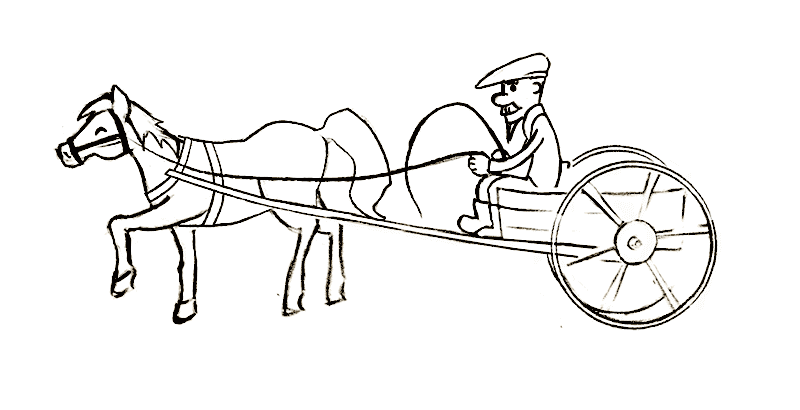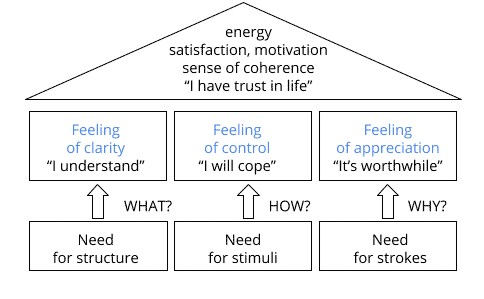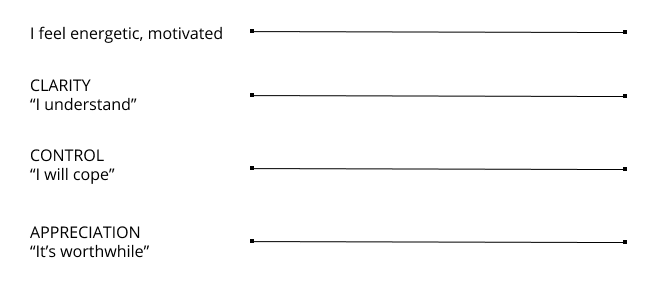Psychological needs at work
This is a post for those seeking to accomplish business goals and ensure stability of the solutions developed while maintaining focus on people. The model of three basic psychological needs that I’m presenting here may be useful for leaders, agile coaches, and scrum masters. I also encourage developers to do some self-reflection. This is the knowledge I’ve gained at the World Conference of Transactional Analysis in Berlin. Transactional Analysis (TA) is a theory of interpersonal relationships developed by Eric Berne which has a practical application in various fields, including organizations.
Do you sometimes lack motivation even after getting positive feedback from your boss or colleagues? Or perhaps you feel that you don’t get acknowledged? Your friends would do anything to have a stable job like yours, while you keep complaining about what you don’t have? Or perhaps it’s the opposite: you’re overwhelmed with the number and the variety of challenges that the company puts in front of you? Or maybe you feel lost because you don’t have a clearly defined role and place in the team? You don’t fully understand your responsibilities and that frustrates you? With a similar level of discomfort at work, it is likely that your basic psychological needs are not being met which affects your feeling of satisfaction and fulfilment. Below is a description of these needs.
Psychological needs: the 3 hungers model #
During her workshop “Psychological Needs – base to develop identity, energize leadership and manage (vanishing) boundaries”, Anke von Platen vividly presented “the 3S model” (strokes, stimuli and structure). These are our 3 basic psychological needs which can be fulfilled or unfulfilled, both at personal and professional level.

Anke started her story with a metaphor. In the picture above, the cart represents the body (hardware), and the horse represents the mind (software). The horse may be running in circles if it doesn’t know where to go. It can be running and straining the body without giving it any rest. The driver manages the whole system. He pays attention to the body and mind. He feeds it and makes sure it gets some rest. Each of us is responsible for taking care of these two aspects; you’re the only person that is able to integrate these two parts so that they are stable and in harmony.
What the mind needs. Transactional Analysis (TA) talks out about 3 basic needs referred to as hungers:
1. Hunger of structure When your hunger of structure is satisfied, it gives you a feeling of clarity (“I understand”). For each person, it can be based on different things. For example, you may need clear business goals, information, clear responsibilities and processes, or a predictable people environment.
2. Hunger of stimuli When your hunger of stimuli is satisfied, it gives you a feeling of control (“I will cope”). I have a feeling of control if there is a good amount of challenges or stimuli for me so that I feel “Yes, I will be able to cope with it”. The feeling of control is based on experience, education, coping with challenges, control of feelings and emotions.
3. Hunger of strokes Strokes are the signs that we get from the people we work with which make us feel that what we do has value. As proof of recognition, we can get a raise or a bonus, and on a daily basis: a code review, listening, feedback, celebrating success, or development. When your hunger of strokes is satisfied, it gives you a feeling of appreciation (“It’s worthwhile”). Sometimes, when we’re not getting enough recognition and appreciation, we subconsciously prompt negative strokes.

By satisfying these hungers, we get the answer to the question of WHAT to do, HOW to do it using our knowledge and experience, and WHY to do it, what we want to achieve by doing this, and what is it that we personally want. We can use this knowledge to perform an analysis using individual or team approach, looking into our own motivation or feeling of satisfaction at work. Each team member can perform self-assessment using these axes. The results can be then compiled for the whole team to see what the team needs to feel good and have the right conditions to work.

Example of self-assessment performed by an individual #
The person on the diagram below is a highly motivated developer. He uses a stretch goal that was set for his team as his main source of energy. He has Clarity as to what is to be done and why, and has experience in the language and architecture that the team wants to use to build the solution (Control). He rated Appreciation as medium.
At this point, this doesn’t affect his satisfaction with work but if his frustration with the unfulfilled need for stimuli or structure gets worse, it’ll be enough to affect his overall satisfaction.

Example of self-assessment performed by a team: Below is a diagram of a team that has been struggling in the last few months with a large number of service errors. It’s a legacy service that was passed from another team. They haven’t had the time for a proper refactoring. The developers keep making patches. Two of them are really fed up with it. The low scores on the Control axis result from the lack of challenges and stimuli that work as a powerful driver for them when developing new functionalities. They are starting to question why their team even exists. The Product Owner appreciates their efforts but at this point, instead of acknowledgement, these two developers need more interesting challenges (Control) or at least Clarity on what they still need to improve and how long this will take. The other two developers are coping with the lack of challenges. They are glad that they’ve been able to work out a previously unfamiliar service which has earned them Appreciation from other teams. This explains the high scores on each axis.

The following questions can help you analyse intuitive scores:
WHAT? Do I know my responsibilities in the team? What is the business goal? Why are we developing this product?
HOW? Do I still find my job interesting or perhaps I feel overwhelmed by the level of complexity? Do I have sufficient resources to cope with?
WHY? How do I know that what I’m doing makes sense? How often do I get acknowledged? What signs of acknowledgement do I need from my co-workers/boss?
What I find interesting is the definition of these terms: what do clarity, control and appreciation mean to me as opposed to our team? Do we understand these terms the same way? What has been provided to us and what is it that we’re missing?
I encourage you to do some self-reflection on your role and the workplace. In her story, Anke often referred to a leader as a person that can manage a project or a team but can leaders successfully manage themselves? As you may guess, she encourages leaders to first make sure that their needs are being met at a satisfactory level so that they can later help their team do the same. This way, leaders become role models who can share their experience of change.
You can successfully use this model during a retrospective or a face-to-face meeting, following the guidance provided above. It was interesting for me to see the contrast between my self-assessment scores for work and for personal life. These are two separate worlds, or two systems where totally different rules can apply: we may care about different things, and accept different things as the norm or as deviation from the norm.
I suggested this exercise to a team leader. He had some interesting insights, and said that a few months ago his scores on each of the axes would have been completely different. The situation changed, and so did the extent to which his needs are being fulfilled. The question is: do we consciously contribute to the improvement of a situation, and if so, to what extent? Or do we tend to go with the flow hoping that we won’t drown? Another important conclusion from this conversation is that we need to accept that each of us, even when working under the same conditions (team, company), may understand the axes and their extreme values differently. One person may get extremely anxious about announced organizational changes, while another person may pay no attention to them (Clarity). Some people may need a lot of feedback and signs of appreciation from their colleagues, while others may derive their satisfaction from their own contentment with the completion of a task (Appreciation). A comparison of each team member’s rates on the axes may be a good reason to talk about what we’re doing, why we’re doing it, and how we feel about it as a team and individually.
